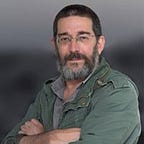Friday 13th is a photographer’s delight
Each Friday 13th of the year, the Archaeological Museum of São Miguel de Odrinhas creates a special show around our fears. This time I took a group of photographers to be frightened. They enjoyed the experience.
October 13 was a Friday, so a new event filled the night of the Museum. I used the opportunity to set a studio in the backstage and take a group of photographers to experience what it is to photograph with LED panels. It’s always an interesting experience, although it is a bit of a challenge, but the results can be rather good, if you persevere.
The public event is a “no no” in terms of photography. Light is scarce, a few candles around the Museum’s room, less than in previous years, I felt, and was confirmed. This make it difficult, in fact almost impossible, but for one or two lucky moments. The rest is pitch black — except for one Xenon flashes from smartphones break the whole atmosphere -, asking for so high ISOs that you better forget the whole story. It’s good to try, but don’t feel bad if nothing good comes out of it. Light is what it is, and without light photographers can not draw their images.
So we settled for the backstage studio, which is itself a challenge, because of the use of LED panels. Yes, you could have LED panels to light everything and beyond, but that would go against the essence of this experience: try to do a lot with little. I mounted two blocks of light, small portable LED panels, the kind of stuff any amateur photographer is willing to purchase, and challenged participants to photograph with those. In fact, I gave them more than I’ve used myself in some occasions, as I’ve worked with a single light and, sometimes, a reflector.
Still, using a number of LED panels that is below the “professional studio light level” — whatever that is — you’re faced with limitations, one of them being the need to either take your ISO higher than some are willing to, the other being, as everything is connected, the need to use wide apertures and slow shutter speeds. This causes all kinds of problems: higher ISO gets you grain, which when removed takes away some detail; wide apertures mean not much is in focus, making it difficult to get sharpness across the subject… many times to the extent that you focus one eye and the other is already out of focus. The last and sometimes most difficult problem is speed, or the lack of it. If you ask the people being photographed to move, you’ll probably get a blurred image, because you’re working with slow shutter speeds — 1/125, /160 or less — to get a well exposed image.
In that sense flash is much better, because it allows you to work at 1/250 or whatever sync your camera does, and depending on your flashes, apertures as f/8, which is great for detail. I tend to take ISO up to 400 ISO in these situations, because it allows me to lower the flash output, meaning it recycles better and gives more flashes per charge. Flash also allows me to better control the relation between subject and background.
One advantage of LED panels is the constant presence of light, which works like continuous tungsten lights in the studio. This helps to see what you’re doing, although with flash you can have some ambient light pointing to your subject, to help with focus, because when you click the shutter only the flash light will be registered. In terms of exposure consistency, both systems work well, once you’ve defined the base exposure for each. LED panels have one little advantage: if nothing goes wrong they are always on. Flash, sometimes, may fail, meaning you’ve to repeat images, meaning there are recycling times involved as well. So, as you see, both systems work, once you understand what they can offer. I enjoy working with both, because of the challenges they place. These images, created October 13th 2017 at the Archaeological Museum of São Miguel de Odrinhas, reveal what can be achieved with a makeshift studio based on small LED panels.
For this Friday 13th experience made I some captures to expand my Museum files, but I was there essentially as the caretaker of the lights. It is always fun to see how people explores these moments.This Halloween I will return to the Museum, for some more photography backstage. In November I will have a workshop there, photographing archaeological artifacts, using LED panels. Some notes about the activity can be found following the link to my website and the One Light over History activity (it’s in Portuguese but you can use an online translator to get an idea)
